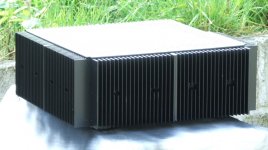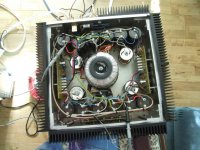Mr. Nelson Pass, back in the day, you used to offer the 30 watt A3 and the 60 watt A5. But now you only offer the xa30.5 (now the xa30.8) for those of us that only have the space for a single stereo amplifier. Why don't you offer us fans a powerful class A stereo model? You offer so many great choices for monoblocks but only the one stereo. Thanks.
Probably because the chassis can't dissipate the heat generated by a larger class A amp.
A larger chassis will also have the space problem, so it is quite easier to manage 2 "smaller" amplifiers than a big one.
A larger chassis will also have the space problem, so it is quite easier to manage 2 "smaller" amplifiers than a big one.
Probably down to consumer demand.
A single 2 x 100W Class A chassis is going to be very heavy, I know, I've got one that weighs just under 50Kg.
A single 2 x 100W Class A chassis is going to be very heavy, I know, I've got one that weighs just under 50Kg.
True but Threshold had several successful 1-box stereo models that were high output class A, didn't they?
I don't know much about Threshold products because that was a little before my time (though my first "high end" preamp was a Forte, I didn't know much about amplifiers back then). Can you explain what you mean?
But anyway, was the 60 wpc Aleph 5 not a successful model? Did it suffer from some of the drawbacks that the above posts mentioned (excessive heat control)? It was not unduly large or heavy.
But anyway, was the 60 wpc Aleph 5 not a successful model? Did it suffer from some of the drawbacks that the above posts mentioned (excessive heat control)? It was not unduly large or heavy.
it simple as that - steady state class A means heat
exact amount of heat demands exact amount of hardware to get rid of
all answers to your questions and dilemmas are in user manuals of old and new PL products
look for figures of dissipation , power , weight , dimensions ..... and size of heatsinks
exact amount of heat demands exact amount of hardware to get rid of
all answers to your questions and dilemmas are in user manuals of old and new PL products
look for figures of dissipation , power , weight , dimensions ..... and size of heatsinks
Aleph 4 100W Pass - Class A is a monster
This beast sheds over 300W in heat alone. It is a real delight to listen to but it is HUGE.
IIRC the commercial products were designed to run a little hotter than my beast. The commercial Aleph 4 ran at about 80-85 degrees C, mine is a bit cooler at 55 = 60 degrees C.
There is a thread on here somewhere when Phil's dad detailed the build.
This beast sheds over 300W in heat alone. It is a real delight to listen to but it is HUGE.
IIRC the commercial products were designed to run a little hotter than my beast. The commercial Aleph 4 ran at about 80-85 degrees C, mine is a bit cooler at 55 = 60 degrees C.
There is a thread on here somewhere when Phil's dad detailed the build.
Attachments
Last edited:
The XA30.5 is very conservatively rated.
It doesn't clip until 130 watts into 8 ohms (1%THD)
and 195 watts into 4 ohms...
So that's a stereo chassis that's good up to "100 watts" --> if you want more power, it's
probably a good idea to start utilizing mono-block chassis for reliability... 😎
It doesn't clip until 130 watts into 8 ohms (1%THD)
and 195 watts into 4 ohms...
So that's a stereo chassis that's good up to "100 watts" --> if you want more power, it's
probably a good idea to start utilizing mono-block chassis for reliability... 😎
This beast sheds over 300W in heat alone. It is a real delight to listen to but it is HUGE.
damn that's massive.
IIRC the commercial products were designed to run a little hotter than my beast. The commercial Aleph 4 ran at about 80-85 degrees C, mine is a bit cooler at 55 = 60 degrees C.
where do you get this numbers from??????
from the aleph 4 manual:
"This amplifier runs hot. The heat sinks will warm up in about an hour to a temperature which
will not be comfortable to touch for more than a moment or two, which is 120 to 130 degrees
Fahrenheit (50 to 55 degrees Celsius). This is normal, and there is a thermal shut off system
which will shut down the amplifier at internal temperatures in excess of 160 deg. F. and 70
deg. C."
conservatively rated
XA60 = XA30, with doubled-size output stage/heatsinks/PS/dissipation
(economy of scale : same toroidal, same 50V type electrolytics, same chassis/heatsinks. Identical routine as in the T-days)
and $11000 versus $5500 too! (or $12800 versus $6500 for the new .8 version). Hence it would be nice to see a 60 watt single chassis stereo offering (like the old Aleph 5)!
where do you get this numbers from??????
from the aleph 4 manual:
"This amplifier runs hot. The heat sinks will warm up in about an hour to a temperature which
will not be comfortable to touch for more than a moment or two, which is 120 to 130 degrees
Fahrenheit (50 to 55 degrees Celsius). This is normal, and there is a thermal shut off system
which will shut down the amplifier at internal temperatures in excess of 160 deg. F. and 70
deg. C."
I think you will find that might be right in an air conditioned room but in the real world they run hotter.
I think you will find that might be right in an air conditioned room but in the real world they run hotter.
i THINK that the 70c thermal shotdown will kick inn long before the amp gets close to 80c. no matter what the ambient is.
i highly doubt that Nelson Pass designed any amp s that MUST have air condition to run.
Last edited:
Heat
In our burn in area at the factory (NOT air conditioned) normal is with time see a 23 degree rise on the sinks over ambient. Amps are if you pardon the expression elbow to elbow and nose to nose.
It's rare that we experience a sink that goes beyond 56C. And as for the heat load, here is something to think about. The average human resting radiates right around 100 watts of heat...... with strenuous exercise almost 700 watts of heat.
Cyclotronguy
In our burn in area at the factory (NOT air conditioned) normal is with time see a 23 degree rise on the sinks over ambient. Amps are if you pardon the expression elbow to elbow and nose to nose.
It's rare that we experience a sink that goes beyond 56C. And as for the heat load, here is something to think about. The average human resting radiates right around 100 watts of heat...... with strenuous exercise almost 700 watts of heat.
Cyclotronguy
Congratulations on the move to the new location CG.
I trust that you are once more back up and running and have lots of room for additional elbows and noses!
Graeme
I trust that you are once more back up and running and have lots of room for additional elbows and noses!
Graeme
Graeme
I think you've seen the old facility, yes. Burn-in once loaded was tight quarters. Now the power-amps and pre-amps each have their own dedicated room and test stands... and storage space. We're loving it!
Cyclotronguy
I think you've seen the old facility, yes. Burn-in once loaded was tight quarters. Now the power-amps and pre-amps each have their own dedicated room and test stands... and storage space. We're loving it!
Cyclotronguy
- Status
- Not open for further replies.
- Home
- Amplifiers
- Pass Labs
- Mr. Nelson, why does Pass Labss only offer one class A stereo model?

